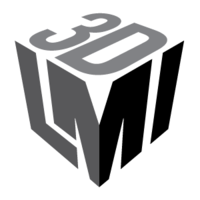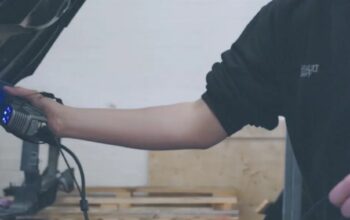Inline surface defect detection on manufactured parts is one of the more common machine vision inspection tasks today. In these applications, engineers often rely on 2D blob analysis to perform an initial segmentation of randomly located regions from the background as part of an overall inspection process. Standard 2D Blob Analysis In 2D blob extraction, one can only isolate the image foreground from the background based on a specified threshold of intensity data. 2D is unable to identify shape-based blobs such as dents or bumps in the surface of a part, or blobs that occur on uneven surfaces (i.e. where this is a step height variation). To address this inspection challenge, we will explore how to carry out 3D surface blob segmentation with a dedicated measurement tool in Gocator called the Surface Blob tool.The Inspection Challenge To illustrate the limitations of 2D blob extraction, we are using this black bracket with a tilted surface and multiple randomly located dents.
 The problem is that the black-on-black (low contrast) surface of the sample target does not allow 2D scanning to capture any usable edges in the foreground blobs, and as a result prevents successful blob segmentation. The Smart 3D Solution – Surface Blob Tool The Surface Blob tool goes above and beyond standard 2D segmentation by allowing you to extract features from shape (3D height map) data. This means you can identify raised or sunken regions from flat surfaces. These flat surfaces can be set as a reference region or reference plane, which also allows you to solve special cases of local surface variation caused by changes in step height, where a single height threshold is insufficient to accurately segment the required feature.
The problem is that the black-on-black (low contrast) surface of the sample target does not allow 2D scanning to capture any usable edges in the foreground blobs, and as a result prevents successful blob segmentation. The Smart 3D Solution – Surface Blob Tool The Surface Blob tool goes above and beyond standard 2D segmentation by allowing you to extract features from shape (3D height map) data. This means you can identify raised or sunken regions from flat surfaces. These flat surfaces can be set as a reference region or reference plane, which also allows you to solve special cases of local surface variation caused by changes in step height, where a single height threshold is insufficient to accurately segment the required feature.
By setting a reference plane and applying the Surface Blob tool, we can now perform 3D blob analysis to identify the sunken, shallow dents in our sample target that are undetectable with 2D intensity. Summary In addition to carrying out typical 2D blob analysis, the Surface Blob tool allows you to extract blobs from 3D height map data in order to identify shape-based features. And, in order to provide greater flexibility and control in your measurement and inspection process, you can now identify sunken or raised features relative to a reference plane or arbitrary region for features lying on tilted surfaces.
Summary In addition to carrying out typical 2D blob analysis, the Surface Blob tool allows you to extract blobs from 3D height map data in order to identify shape-based features. And, in order to provide greater flexibility and control in your measurement and inspection process, you can now identify sunken or raised features relative to a reference plane or arbitrary region for features lying on tilted surfaces.
The Surface Blob tools come onboard every Gocator® 3D smart sensor. To explore more of these 150+ built-in measurement tools, visit the Firmware page of our website.









